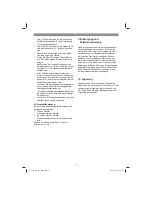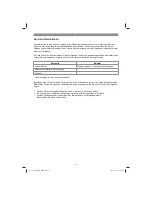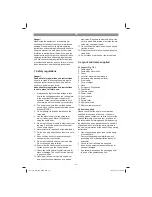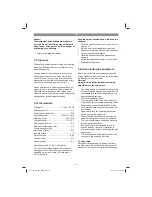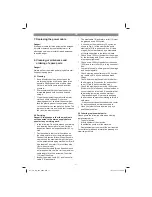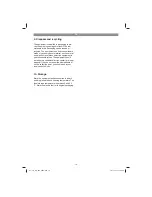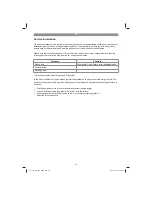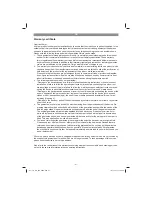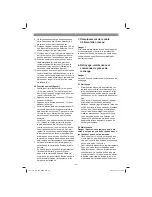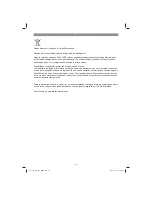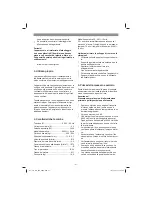
GB
- 16 -
5.2 Assembly (Fig. 5)
The cable hoist is
fi
tted with two fastening bars
(1) with which it has to be fastened to a rectangu-
lar tube. The dimensions of the arm must conform
with the size of the fastening bars (1) and must
be capable of supporting twice the rated load. We
recommend that you seek advice from a quali
fi
ed
technician.
All screws must be tightened correctly. A quali
fi
ed
technician should check the anchoring of the arm
before the machine is started.
5.3 Block and tackle function (Fig. 6 – 9)
The cable hoist is
fi
tted with a return roller (15)
and an additional hook (16). If these parts are
used correctly, the cable hoist can lift twice its
rated load.
Fit the return roller (15) and additional hook (16)
as shown in Figure 6 – 8. The permanent hook (8)
must be attached to the fastening hole (2) (Fig. 9).
The load is now raised by two steel cables, which
means that the cable hoist can lift twice its rated
load.
6. Operation
Danger!
6.1 Information for operation
1. Remove the adhesive tape from the drum (3)
before using the hoist for the
fi
rst time.
2. The value of the A-rated noise emissions
at the operator’s position is less than 75 dB
(sound pressure level LpA). Sound and vib-
ration values were measured in accordance
with EN ISO 11201.
3. Supply voltage: 230 V ± 10%, 50 Hz ± 1%.
4. The cable hoist must be operated in ambient
temperatures of between 0°C and 40°C with
a relative humidity of less than 50%. Height
above sea level: max. 1,000 m.
5. The temperature for transport and storage
may be between -25°C and 55°C. The maxi-
mum temperature must not exceed 70°C.
6. The user should lift the load o
ff
the ground at
the slowest possible speed. The cable should
be taut when the load is raised.
7. The motor (14) for the cable hoist is
fi
tted with
a thermostat switch. Whilst the cable hoist is
operating, the motor (14) may therefore stop.
It will restart automatically when it has cooled
down.
8. The electric cable hoist is not
fi
tted with a
rated power limiter. You should therefore not
repeat attempts to lift a load if the overload
trip is limiting the hoist’s operation. In this
case the load exceeds the rated capacity of
the cable hoist.
9. Do not leave any suspended loads unsuper-
vised without
fi
rst taking the appropriate safe-
ty precautions.
10. Fit the machine with a 10 A fuse or a 10 mA
residual current operated circuit breaker
(RCCB) to protect the circuit
11. Do not use the lever (4/5) as a routine stop-
ping device. It should only be used to stop the
machine in an emergency.
12. Before you start, ensure that the steel cable
(6) is correctly wound around the drum (3)
and that the spacing between the windings is
smaller than the steel cable (Fig. 3)
13. Ensure that the load is correctly secured to
the hook (8) or, if you are using the block and
tackle, the additional hook (16) and always
maintain a safe distance from the load and
the steel cable (6).
6.2 Operation (Fig. 10)
•
Check whether the Emergency Stop switch
(9) is pressed. Turn the red stop switch clock-
wise to release it.
•
Press the pushbutton
▲
(10) to raise the load.
•
Press the pushbutton
▼
(10) to lower the
load.
•
Automatic stop mechanism lever (5): When
the maximum lifting height has been reached,
the cut-out weight (7) presses the lever (5)
upwards. This trips a limit switch after which
the load cannot be raised any further.
•
Lever for maximum cable length (4): When
the load has reached its lowest possible po-
sition, a limit switch is tripped which makes it
impossible to lower the load any further. This
limit switch also prevents the cable hoist ope-
rating in the wrong direction (hook moving in
the opposite direction to the arrow shown on
the control switch).
•
The cable hoist will stop if the Emergency
Stop switch (9) is pressed.
•
In an emergency, immediately press the
Emergency Stop switch (9) to stop the cable
hoist. The cable hoist cannot be operated
if the Emergency Stop switch has been
pressed.
Anl_TC_EH_500_SPK9.indb 16
Anl_TC_EH_500_SPK9.indb 16
16.11.2017 15:22:00
16.11.2017 15:22:00








